Brides to be … it is your wedding day and please allow us to congratulate you. As you are probably aware, wedding planning is a fantastically challenging process and there are times of utter confusion when making certain decisions. Bridal makeup and hair styling is definitely one of them!
While we know, you love to be in "the know" of the latest makeup trends (tutorials on blogs and video sites, always stopping by a makeup counter to try out a new launch), but you when it comes to your wedding day look what style do you go with???
While working with brides for over 20 years, one thing has always been consistent in my interaction with my North American & European brides. They want to look flawless and natural, but glamorous and not caked-up. Here are some guidelines on how to achieve this goal.
Do's
1. Do start looking for a professional artist at least 6 months before the big day, especially if your wedding is on a Saturday or a long weekend.
2. Do put aside a realistic budget for your beauty. There will be a higher price tag if you expect the artist to remain with you the entire wedding day. Try offering the artist more clients to work with at your wedding to make it worth their time commitment.
3. Do get comfortable with your artist's style. This includes reviewing their portfolio, considering recommendations from their previous clients, and a one-on-one consultation and trial makeup session.
4. Do set aside a budget for the trial sessions. Remember that the artist is investing time and talent to help finalize a look that looks exquisite on you.
5. Do have your outfit with you when you set up a trial session. A black T-shirt will not represent your wedding day outfit and therefore will not be able to fully translate the impact of the final look!
6. Do take your dupatta/chunni to your hair trial, especially if you need to have your head covered during the ceremony. Many a fabulous hair style succumbs to the weight of an embroidered chunni, so the hairstyle has to be pretty, as well as functional.
7. Do take pictures as reference, but remember that every look will have to be translated to reflect your features, hair, and skin tone. The Jodha Akbar look when replicated on you will be your version of it, not Aishwarya Rai's.
8. Do be open to your artist’s recommendations. They do this for a living and know how certain colors and intensities will turn out in pictures. It is always best to take pictures before, then with an initial trial and then a stepped up style to see how the looks look on film.
9. Do try out different styles of eyelash enhancements - extensions, individual lashes or custom made full sets. They look spectacular and mascara is no match for what they can do for your eyes!
10. Do remember that colors look different in different lighting situations. If you get a trial session done for an evening event that is going to be in the soft mood lighting of a hotel, don't judge your makeup by looking at it in sunlight as it will look too bold.
Don'ts
1. Don't attempt to do your own hair and makeup. The bride has an enormous amount of nervous energy during those last few hours leading up to the wedding.
2. Don't ask a best friend or aunty to do it either. Yes, your friend does an amazing job with makeup when you go out to party, but can she make it work for different lighting situations and for professional photography? Does she have an array of professional grade tools and products on hand to do emergency fixes for stress related acne that just showed up or really dark circles that reflect the sleepless nights of the week preceding the wedding?
3. Don't try to cut corners on cost by going to a makeup counter to get a makeup for product purchase deal. Do you really want to run around the mall on your wedding day?
4. Don't show up at your consultation and trial session without taking care of grooming. Out of shape brows, facial hair and peeling skin will never let the flawless, perfect look come into play.
5. Don't opt for a trendy look for your wedding. If you must follow a trend, do so on the night of the sangeet. You really don't want to look time stamped on your wedding day.
6. Don't insist on dark eyes and nude lips for the wedding. Nude lips will not show up in the photographs and you will look washed out.
7. Don't go with an all out shimmery look to replicate the look you see on magazine cover shoots. It will make you look like a disco ball! Instead, keep the shimmer and sheen for your eyes with just a tad bit on your cheekbones.
8. Don't keep your hair all down for the garba and reception if you want to dance the night away (Although I did not follow this because my significant other wanted my hair down...he still owes me for this one ;) The energy, movement and passion of the moment will make you sweat and your hair will stick to your face and neck … not very pretty!
9. Don't believe everything you read about beauty products. Airbrush makeup does not last for over 18 hours and unless you use a perming chemical for curls, your curls will get looser, softer and more open as the hours progress.
10. Don't take too many suggestions from multiple friends and family after a trial session. Everyone has their own taste and viewpoint which may end up frustrating you. Let this be your decision and work with your artist until you discover the look you love!

 SIX YARDS of sheer grace and elegance is what the sari is all about. A Sari is one of the most elegant attires a woman can adorn. It is essentially an un-stitched long piece of fabric which needs to be draped in a particular way to achieve the fully dressed effect. Draping a sari is an art. The saree is worn in in different ways in different states of India. However, the most common method is wrapping the cloth around the waist, making pleats in the front and draping the final length around the shoulder. The remaining fabric that is draped over her blouse and shoulder, falling behind her is called the pallu.
SIX YARDS of sheer grace and elegance is what the sari is all about. A Sari is one of the most elegant attires a woman can adorn. It is essentially an un-stitched long piece of fabric which needs to be draped in a particular way to achieve the fully dressed effect. Draping a sari is an art. The saree is worn in in different ways in different states of India. However, the most common method is wrapping the cloth around the waist, making pleats in the front and draping the final length around the shoulder. The remaining fabric that is draped over her blouse and shoulder, falling behind her is called the pallu.





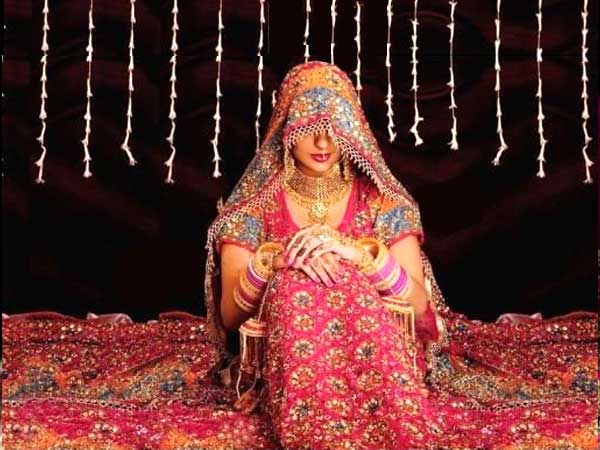







 The stick-on bindis are small decorative motifs which are worn on the forehead, usually with traditional Indian attires. These come in various designs and colors some with stones studded into them. The patterns could include sun, moon, star, lotus, peacock, conch, shell, leaf, snake, paisley, swastika and geometrical designs. Another form of bindi includes tikkas and itlaks worn by both men and women. Bindis are available in liquid form, cream base or as stick-ons.
The stick-on bindis are small decorative motifs which are worn on the forehead, usually with traditional Indian attires. These come in various designs and colors some with stones studded into them. The patterns could include sun, moon, star, lotus, peacock, conch, shell, leaf, snake, paisley, swastika and geometrical designs. Another form of bindi includes tikkas and itlaks worn by both men and women. Bindis are available in liquid form, cream base or as stick-ons. 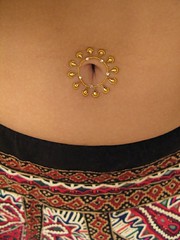 The Stick on bindis can be used in different ways other than the traditional way of sticking it on the forehead. They can be arranged to form various patterns to adorn any part to the body as temporary stick-on tattoos.
The Stick on bindis can be used in different ways other than the traditional way of sticking it on the forehead. They can be arranged to form various patterns to adorn any part to the body as temporary stick-on tattoos. 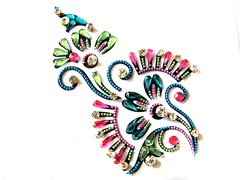
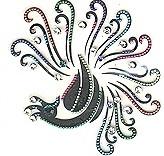
 Bangles are a common accessory while wearing tradition Indian attire.
Bangles are a common accessory while wearing tradition Indian attire.  Adorning bangles in arms has been an Indian tradition since time immemorial. Bangles enhance the overall grace and beauty of the Indian woman as well as perfectly complement Indian ethnic or casual Indian wear.Bangles are solid in form and usually not flexible as in the case of bracelets. Bangles made of glass in different colors are the most popular type of bangles. The word bangle is originally derived from the Hindi word "bungri". Bangles form the most essential part of traditional Indian jewellery, and are usually worn in pairs on one or both wrists. Besides glass, bangles are also made of numerious precious as well non-precious materials like gold, silver, steel, platinum, wood, ferrous, metal, plastic etc. The designs vary from plain or simple to intricately ornate patterns studded with precious or semi-precious gems or stones like diamonds, pearls or other gems.
Adorning bangles in arms has been an Indian tradition since time immemorial. Bangles enhance the overall grace and beauty of the Indian woman as well as perfectly complement Indian ethnic or casual Indian wear.Bangles are solid in form and usually not flexible as in the case of bracelets. Bangles made of glass in different colors are the most popular type of bangles. The word bangle is originally derived from the Hindi word "bungri". Bangles form the most essential part of traditional Indian jewellery, and are usually worn in pairs on one or both wrists. Besides glass, bangles are also made of numerious precious as well non-precious materials like gold, silver, steel, platinum, wood, ferrous, metal, plastic etc. The designs vary from plain or simple to intricately ornate patterns studded with precious or semi-precious gems or stones like diamonds, pearls or other gems. Jute is a plant fiber used in making ropes and sacks. However, recognizing the importance of this invaluable fiber, it is commonly termed as the "golden fiber" as it finds its application in the manufacture of many useful products.
Jute is a plant fiber used in making ropes and sacks. However, recognizing the importance of this invaluable fiber, it is commonly termed as the "golden fiber" as it finds its application in the manufacture of many useful products.  Therefore, it has deftly slipped into fashion circuit. Jute bags available in myriad colors, designs, shapes, sizes and patterns; are a roaring success in the international fashion circuit as well.
Therefore, it has deftly slipped into fashion circuit. Jute bags available in myriad colors, designs, shapes, sizes and patterns; are a roaring success in the international fashion circuit as well.  Shawls and Stoles in various materials, colors and patterns are making a huge statement in the fashion industry worldwide. Indian cashmere and pashmina shawls are sought after everywhere. These shawls and stoles can be found with traditional Indian embroidery patterns like the paisley, elephants, peacocks and so on.
Shawls and Stoles in various materials, colors and patterns are making a huge statement in the fashion industry worldwide. Indian cashmere and pashmina shawls are sought after everywhere. These shawls and stoles can be found with traditional Indian embroidery patterns like the paisley, elephants, peacocks and so on.
 The traditional footwear essentially comprises of Mojaris, Punjabi Juttis, Kolhapuris, Leather Shoes, Handmade shoes and beaded shoes.
The traditional footwear essentially comprises of Mojaris, Punjabi Juttis, Kolhapuris, Leather Shoes, Handmade shoes and beaded shoes. 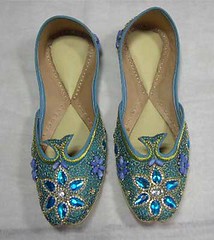 All these essentially complement Indian ethnic or Indian casual wear perfectly. These are available for both males and females usually in varied colors and sizes.
All these essentially complement Indian ethnic or Indian casual wear perfectly. These are available for both males and females usually in varied colors and sizes.

 India being so diverse culturally and geographically, almost every region and state in Indian has their own attire.
India being so diverse culturally and geographically, almost every region and state in Indian has their own attire.
 The Sari is probably the best known item of Indian clothing, it is instantly recognizable and all who see it instantly associate it with India. It is essentially an un-stitched long piece of fabric which needs to be draped in a particular way to achieve the fully dressed effect. The Sari is said to be one of the oldest forms of clothing in India. The saree is worn in in different ways in different states of India. However, the most common method is wrapping the cloth around the waist, making pleats in the front and draping the final length around the shoulder. The Sari is considered formal attire in India.
The Sari is probably the best known item of Indian clothing, it is instantly recognizable and all who see it instantly associate it with India. It is essentially an un-stitched long piece of fabric which needs to be draped in a particular way to achieve the fully dressed effect. The Sari is said to be one of the oldest forms of clothing in India. The saree is worn in in different ways in different states of India. However, the most common method is wrapping the cloth around the waist, making pleats in the front and draping the final length around the shoulder. The Sari is considered formal attire in India.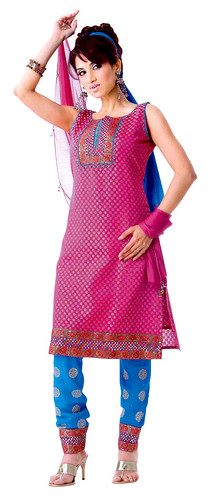 The Salwar Kameez is probably the most popular of all the Indian clothes. Originally from the Punjab and Kashmir, it is now worn throughout India and by most Indian women living abroad. It’s popularity is due to the fact that is is comfortable, practical, modest yet incredibly elegant and stylish, so much so that it is even becoming popular amongst Western women. Sari's are now reserved more for formal functions and occasions. In the North Punjabi girls and women wear salwar kameez`s with bright colored duppattas.
The Salwar Kameez is probably the most popular of all the Indian clothes. Originally from the Punjab and Kashmir, it is now worn throughout India and by most Indian women living abroad. It’s popularity is due to the fact that is is comfortable, practical, modest yet incredibly elegant and stylish, so much so that it is even becoming popular amongst Western women. Sari's are now reserved more for formal functions and occasions. In the North Punjabi girls and women wear salwar kameez`s with bright colored duppattas. 
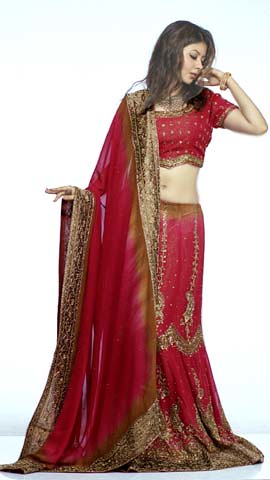
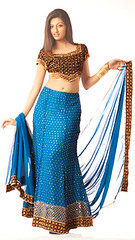

 The 'pancha' in Telugu, called dhoti in Hindi, 'Laacha' in Punjabi, 'mundu' in Malayalam, 'dhuti' in Bangla, 'veshti' in Tamil, 'dhotar' in Marathi and 'panche' in Kannada, is the traditional garment of men's wear in India. It is a rectangular piece of unstitched cloth, usually around 5 yards long, wrapped about the waist and the legs, and knotted at the waist.
The 'pancha' in Telugu, called dhoti in Hindi, 'Laacha' in Punjabi, 'mundu' in Malayalam, 'dhuti' in Bangla, 'veshti' in Tamil, 'dhotar' in Marathi and 'panche' in Kannada, is the traditional garment of men's wear in India. It is a rectangular piece of unstitched cloth, usually around 5 yards long, wrapped about the waist and the legs, and knotted at the waist. Sherwani is a coat-like garment buttoned in the front, which reaches down to the knees, or lower. Usually has embroidery or some other type of work on it.A sherwani coat fits close to the body, fastened in the front with buttons, and extends to slightly below knee-length. Sherwanis are usually embroidered or detailed in some way. It's a formal version of a kurta and worn by boys and men at formal functions and occasions. A Sherwani is worn with chudidar bottoms or a dhoti style bottom and is completed with a dupatta and traditional Indian shoes called
Sherwani is a coat-like garment buttoned in the front, which reaches down to the knees, or lower. Usually has embroidery or some other type of work on it.A sherwani coat fits close to the body, fastened in the front with buttons, and extends to slightly below knee-length. Sherwanis are usually embroidered or detailed in some way. It's a formal version of a kurta and worn by boys and men at formal functions and occasions. A Sherwani is worn with chudidar bottoms or a dhoti style bottom and is completed with a dupatta and traditional Indian shoes called  The lungi is a type of wrap-around garment worn in many of the southern states of India. It's a rectangular piece of cloth little bigger than a towel and is wrapped around kind of like a sarong. In Kerala the lungi, locally known as Kaili or Kalli Mundu, is worn by both men and women. It is considered a casual dress or working dress of physical labourers. Lungis are generally colourful, and with varying designs. The plain white version of a lungi is known as a mundu. For more ceremonial occasions (like weddings), mundus often bear a golden embroidery known as kasavu.
The lungi is a type of wrap-around garment worn in many of the southern states of India. It's a rectangular piece of cloth little bigger than a towel and is wrapped around kind of like a sarong. In Kerala the lungi, locally known as Kaili or Kalli Mundu, is worn by both men and women. It is considered a casual dress or working dress of physical labourers. Lungis are generally colourful, and with varying designs. The plain white version of a lungi is known as a mundu. For more ceremonial occasions (like weddings), mundus often bear a golden embroidery known as kasavu.
 Henna, also known as Heena, is a form of body art that has existed since ancient times. Mehndi (or Henna) is the application of henna as a temporary form of skin decoration, in countries like Egypt, Iran, Pakistan, Syria, Morocco, Yemen, and Somaliland. It is typically employed for special occasions, particularly weddings. It is usually drawn on the hands and feet, where the color will be darkest.
Henna, also known as Heena, is a form of body art that has existed since ancient times. Mehndi (or Henna) is the application of henna as a temporary form of skin decoration, in countries like Egypt, Iran, Pakistan, Syria, Morocco, Yemen, and Somaliland. It is typically employed for special occasions, particularly weddings. It is usually drawn on the hands and feet, where the color will be darkest.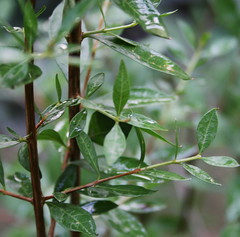 Henna is a flowering plant, the sole species in the genus Lawsonia in the family Lythraceae. It is native to tropical and subtropical regions of Africa, southern Asia, and northern Australasia in semi-arid zones. Henna is a tall shrub or small tree, 2–6 m high.
Henna is a flowering plant, the sole species in the genus Lawsonia in the family Lythraceae. It is native to tropical and subtropical regions of Africa, southern Asia, and northern Australasia in semi-arid zones. Henna is a tall shrub or small tree, 2–6 m high. Henna, produces a red-orange dye molecule called lawsone. This molecule has an affinity for bonding with protein, and thus has been used to dye skin, hair, fingernails, leather, silk and wool. It is usually drawn on the hands and feet, where the color will be darkest because the skin contains higher levels of keratin which binds permanently to lawsone, the colorant of henna.
Henna, produces a red-orange dye molecule called lawsone. This molecule has an affinity for bonding with protein, and thus has been used to dye skin, hair, fingernails, leather, silk and wool. It is usually drawn on the hands and feet, where the color will be darkest because the skin contains higher levels of keratin which binds permanently to lawsone, the colorant of henna. 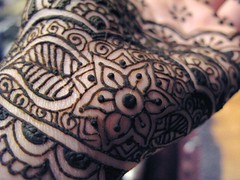 Henna has been used to adorn young women’s bodies as part of social and holiday celebrations since the late Bronze Age in the eastern Mediterranean. Henna was regarded as having “Barakah”, blessings, and was applied for luck as well as joy and beauty. Brides typically had the most henna, and the most complex patterns, to support their greatest joy, and wishes for luck. Some bridal traditions were very complex, such as those in Yemen, where the Jewish bridal henna process took four or five days to complete, with multiple applications and resist work.
Henna has been used to adorn young women’s bodies as part of social and holiday celebrations since the late Bronze Age in the eastern Mediterranean. Henna was regarded as having “Barakah”, blessings, and was applied for luck as well as joy and beauty. Brides typically had the most henna, and the most complex patterns, to support their greatest joy, and wishes for luck. Some bridal traditions were very complex, such as those in Yemen, where the Jewish bridal henna process took four or five days to complete, with multiple applications and resist work.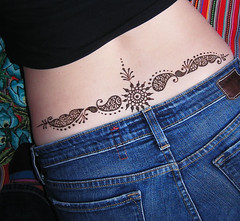 Henna painting has become very popular as a form of temporary tattoo and is liked by a lot. The best aspect of henna is that it is totally natural, made from a plant plant whose leaves are first dried and then crushed to make a fine powder. While applying, the powder is mixed with water. This makes henna totally safe to use. Along with that, its application is totally painless and the effect is temporary. You can use henna to get tattoos, without worrying about pain or infection. In case you are not satisfied with a particular tattoo, just wait for a few days. Its color will soon wash off and you can easily go for another design.
Henna painting has become very popular as a form of temporary tattoo and is liked by a lot. The best aspect of henna is that it is totally natural, made from a plant plant whose leaves are first dried and then crushed to make a fine powder. While applying, the powder is mixed with water. This makes henna totally safe to use. Along with that, its application is totally painless and the effect is temporary. You can use henna to get tattoos, without worrying about pain or infection. In case you are not satisfied with a particular tattoo, just wait for a few days. Its color will soon wash off and you can easily go for another design. 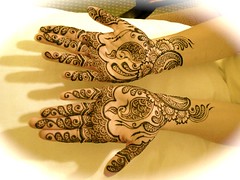 Though there are no set patterns or designs for Henna, there are some popular designs that have been followed since ages. One of the most popular designs is a paisley that is often filled with a checkerboard pattern. Another popular pattern is a lovely peacock, with the sharp and curved beak and the corona on the head. Floral patterns are quite popular as well.
Though there are no set patterns or designs for Henna, there are some popular designs that have been followed since ages. One of the most popular designs is a paisley that is often filled with a checkerboard pattern. Another popular pattern is a lovely peacock, with the sharp and curved beak and the corona on the head. Floral patterns are quite popular as well. 




